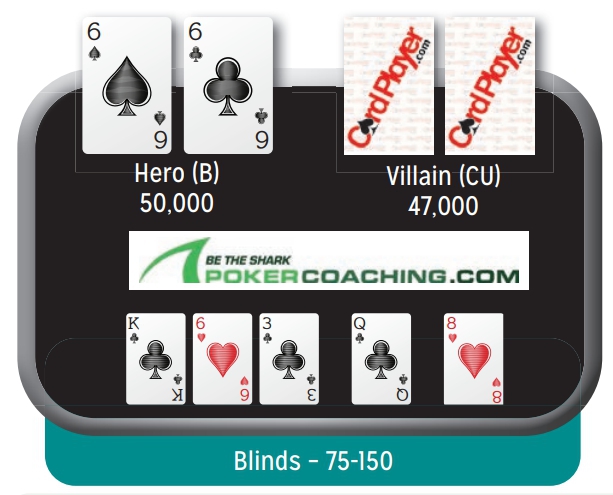






Poker Coaching Hand Quiz: Flopping A Set In A Multi-Way PotDevelop Your Poker Skills And Learn How To Crush Games At PokerCoaching.com/CardPlayer |
|
|
Join more than 120,000 online poker players worldwide who have taken their game to the next level. To develop your poker skills and learn how to crush games, check out PokerCoaching.com.
Key Concept: Flopping A Set In A Multi-Way Pot

It is early in a $3,500 buy-in main event and you are eight-handed. You have 50,000 chips with the blinds at 75-150 when the lojack raises to 400. The cutoff calls and you are on the button holding 6 6
6 .
.
Question 1: Should you fold, call, re-raise to 1,200, or reraise to 2,200?
Answer: With small and medium pairs, you almost always want to just call a preflop raise to try and flop a set or a marginal made hand. Reraising should be avoided because it puts you in a terrible spot unless everyone folds. If you do decide to reraise, use a large sizing to avoid giving your opponents excellent pot odds to stay in and out flop you.
You call and the big blind calls as well. The flop comes K 6
6 3
3 and it checks to you.
and it checks to you.
Question 2: Should you check, bet 600, bet 1,200, or bet 1,800?
Answer: While it is unlikely anyone has a strong hand, you definitely want to bet your best made hands and your draws. The big blind may have a king that will call, but it is doubtful either the lojack or cutoff have one because they probably would have bet it. Betting small for 600 is discouraged because not only do you miss out on substantial value but it also gives your opponents amazing odds to stay in with their draws that can improve to beat your set.
You bet 1,200 and only the cutoff calls. The turn is the Q and your opponent checks.
and your opponent checks.
Question 3: Should you check, bet 1,500, bet 3,000, or bet 4,500?
Answer: The first question you should ask yourself is, “how is my opponent going to play a king if I bet?” Some players will fold hands as strong as a king whereas others wouldn’t even fold a hand like 8-8. If your opponent happens to be a calling station who will never fold a pair, betting on the bigger side is the ideal play. If they are more cautious and will fold most pairs to a large bet, you should consider betting smaller, or even checking.
While 1,500 is the best sizing, you could bet slightly larger for 2,000 to prevent offering your opponent too good of pot odds to stay in with a club. If you are playing live and can tell your opponent loves their hand, then you should definitely check behind because it is certainly possible you are against a flush. Pay attention and adjust accordingly.
You bet 1,500 and your opponent raises to 3,500.
Question 4: Should you fold, call, reraise to 6,000, or reraise to 10,000?
Answer: Reraising is a terrible play because you will only get called by flushes that beat your set. While your opponent’s small raise is somewhat confusing, this is an easy call considering the wide variety of hands they could have as well as your potential of improving to a full house.
The river is the 8 and your opponent bets 2,800 (25% pot).
and your opponent bets 2,800 (25% pot).
Question 5: Should you fold, call, raise to 6,500, or raise to 10,200?
Answer: Facing a tiny river bet, you have no choice but to call. While you are against a flush a lot of the time, there is still a chance they are betting this way with two pair or one pair. If you think your opponent is only trying to get value from a flush you could consider folding, but should only do this if you are certain. Calling may be costly, but folding the better hand is far costlier.
You call and your opponent reveals the 5 2
2 . While you may have lost the hand, you conserved chips that you can utilize later in the tournament.
. While you may have lost the hand, you conserved chips that you can utilize later in the tournament.
For access to more than 1,200 interactive poker hand quizzes just like this, but in video format, visit PokerCoaching today.
